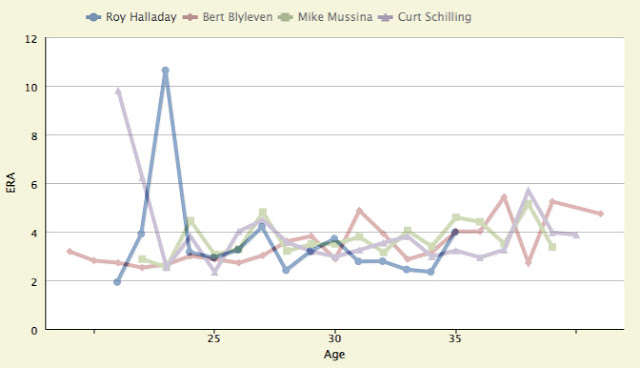Given
the information currently at our disposal, it appears that Roy Halladay is out
with a lat strain for the next 6-8 weeks, leaving the Phillies in quite a
precarious position. While the
team has won 5 of its last 6 and sits 2 games above .500 for the season, they
are still in last place in the NL East, and the one loss was the game in which
Halladay left early with the injury.
However, Phillies fans should realize how spoiled they’ve been for the
past few seasons, and understand that the Halladay of 2011 is not likely to
return, even after 8 weeks.
First
of all, let’s take into account that Halladay is 35 years old. Last year, just 5 pitchers age 35 or
older threw at least 200 innings, and 5 had an ERA of under 4.00 – Chris
Carpenter, Tim Hudson, R.A. Dickey, and Hiroki Kuroda fit both bills. From 2008 to 2011 (ages 31-34),
Halladay averaged over 240 innings per season and had his four highest
strikeout rate seasons, four of his seven lowest walk rate seasons, and four of
his five lowest ERA seasons, so it’s safe to assume that without an injury, he
would have done just fine. But how
good could we really expect him to be?
Halladay
has been nothing short of amazing since 2006, leading many to believe that he
would be dominant for quite some time beyond this year. From ages 29 to 34, no one except Greg
Maddux accrued more Wins Above Replacement than Halladay in the modern
era. Names like Bob Gibson,
Gaylord Perry, Jim Palmer, and Tom Seaver are the only ones above Halladay in
both innings pitched and ERA over that age range. He is sixth in wins by 29-34 year old pitchers, and his
winning percentage is comparable only with Maddux, Randy Johnson, Pedro
Martinez, and Whitey Ford (minimum 1000 IP).
However,
time takes its toll eventually.
Most pitchers begin to decline around age 35, and certainly injury
becomes a concern before that.
Halladay has started between 31 and 33 games each of the past six years,
an incredible run of health that seemed destined to end at some point. And even if you grant him the benefit
of the doubt that injury kept his statistics as “bad” as they were thus far
this season, it really should be expected that he decline right about now.
From
the above graph of four (soon to be Hall of Fame) pitchers’ ERA trends over
their careers, you can see that their prime years (with the exception of
Blyleven’s early career) lie right between ages 28 and 34. However, after age 35, Blyleven,
Mussina, and Schiling all declined and/or became quite inconsistent ERA-wise,
and it appears likely that Halladay will do similarly. While it is unreasonable to expect that
his ERA will stay as high as it is (especially given that his K, BB, and HR
statistics are quite similar to previous years in which he was just fine), I
think that upon his return, Roy Halladay will not be the same pitcher Phillies
fans have seen dominate the National League since 2010. At 35, we really shouldn’t expect that
of him.
We should be expecting
that of Cole Hamels.


No comments:
Post a Comment